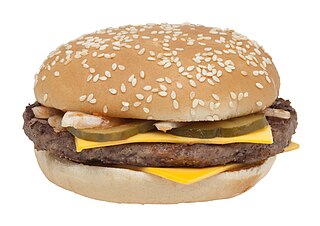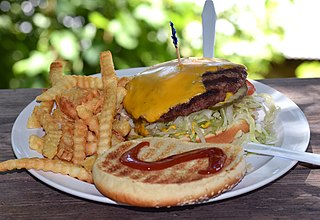
A hamburger, or simply burger, is a food consisting of fillings—usually a patty of ground meat, typically beef—placed inside a sliced bun or bread roll. Hamburgers are often served with cheese, lettuce, tomato, onion, pickles, bacon, or chilis; condiments such as ketchup, mustard, mayonnaise, relish, or a "special sauce", often a variation of Thousand Island dressing; and are frequently placed on sesame seed buns. A hamburger patty topped with cheese is called a cheeseburger.

A cheeseburger is a hamburger with a slice of melted cheese on top of the meat patty, added near the end of the cooking time. Cheeseburgers can include variations in structure, ingredients and composition. As with other hamburgers, a cheeseburger may include various condiments and other toppings such as lettuce, tomato, onion, pickles, bacon, avocado, mushrooms, mayonnaise, ketchup, and mustard.

The cuisine of California reflects the diverse culture of California and is influenced largely by Hispanic American roots, alongside East Asian and Oceanian influences, and Western European influences, as well as the food trends and traditions of larger American cuisine.

In-N-Out Burger is an American regional chain of fast food restaurants with locations primarily in California and to a lesser extent the Southwest from Oregon to Texas. It was founded in Baldwin Park, California, in 1948 by Harry (1913–1976) and Esther Snyder (1920–2006). The chain is currently headquartered in Irvine, California and has expanded outside Southern California into the rest of California, as well as into Arizona, Nevada, Utah, Texas, Oregon, and Colorado, and is planning expansions into Idaho, New Mexico, and Tennessee. The current owner is Lynsi Snyder, the Snyders' only grandchild.

MOS Food Services, Inc., doing business as MOS Burger, is an international fast-food restaurant chain (fast-casual) from Japan. Its headquarters are in the ThinkPark Tower in Ōsaki, Shinagawa, Tokyo. At one time its headquarters were located in Shinjuku, Tokyo.

Krystal is an American regional fast food restaurant chain headquartered in Dunwoody, Georgia, with restaurants in the Southeastern United States and Puerto Rico. It is known for its small, square hamburgers, called sliders in places other than the Southeast, with steamed-in onions. Krystal moved its headquarters from Chattanooga, Tennessee, where it had been based since 1932, to the Atlanta suburb of Dunwoody in early 2013.

Burger Chef was an American fast-food restaurant chain. It began operating in 1954 in Indianapolis, Indiana, expanded throughout the United States, and at its peak in 1973 had 1,050 locations, including some in Canada. The chain featured several signature items, such as the Big Shef and Super Shef hamburgers.

Marriott Corporation was a hospitality company that operated from 1927 until 1993, founded by J. Willard Marriott and Frank J. Kimball as Hot Shoppes, Inc. In 1957, Marriott Corporation opened its first hotel in Arlington County, Virginia, United States as the Twin Bridges Motor Hotel.

Different areas of the world have local variations on the hot dog, in the type of meat used, the condiments added, and its means of preparation.

May Company California was an American chain of department stores operating in Southern California and Nevada, with headquarters in North Hollywood, California. It was a subsidiary of May Department Stores and merged with May's other Southern California subsidiary, J. W. Robinson's, in 1993 to form Robinsons-May.

Bob's Big Boy is a restaurant chain founded by Bob Wian in Southern California in 1936, originally named Bob's Pantry. It is now part of Big Boy Restaurant Group, the current primary trademark owner and franchisor of the Big Boy system. At its peak in 1989, there were over 240 Bob's locations throughout the United States, most belonging to Marriott. As of November 2023, the company operates 4 locations in California. Those four locations are in Burbank, Downey, Norco, and Northridge. Two of these restaurants are now protected historic landmarks: the Burbank location on Riverside Drive and the Downey location, previously known as Johnie's Broiler. In August 2020, plans were announced to open a Bob's Big Boy in Indian Springs, Nevada. The restaurant opened on November 8, 2020 as Big Boy without the Bob's branding, with future expansion planned across Southern Nevada.
A hamburger is a sandwich that consists of a cooked ground meat patty, usually beef, placed between halves of a sliced bun. Hamburgers are often served with various condiments, such as dill relish (condiment), mayonnaise, and other options including lettuce, tomato, onion, pickles, and cheese.

The May Company Building on Broadway in Downtown Los Angeles, a.k.a. Hamburgers/May Company Department Store and the May Department Store Building, later known as the California Broadway Trade Center, was the flagship store of the May Company California department store chain. It is a contributing property to the NRHP-listed Broadway Theater and Commercial District.

Chili mac is a dish prepared using chili con carne and macaroni as primary ingredients, which is often topped or intermingled with cheese. Some versions are made using prepared or homemade macaroni and cheese. It is a common dish in the cuisine of the Midwestern United States, and is also popular in other areas of the United States.

Hamburger Hamlet or "The Hamlet", was a chain of restaurants based in Los Angeles, a point of reference for Angelenos and for the creative industries that were located in the city. Opened in 1950 by film actor Harry Lewis with his future wife Marilyn (m.1952), it grew to a chain of 24 locations, including Chicago and the Washington, D.C. metro areas. before they were all either sold or closed down.

Dick's Primal Burger is a restaurant in Portland, Oregon.
















